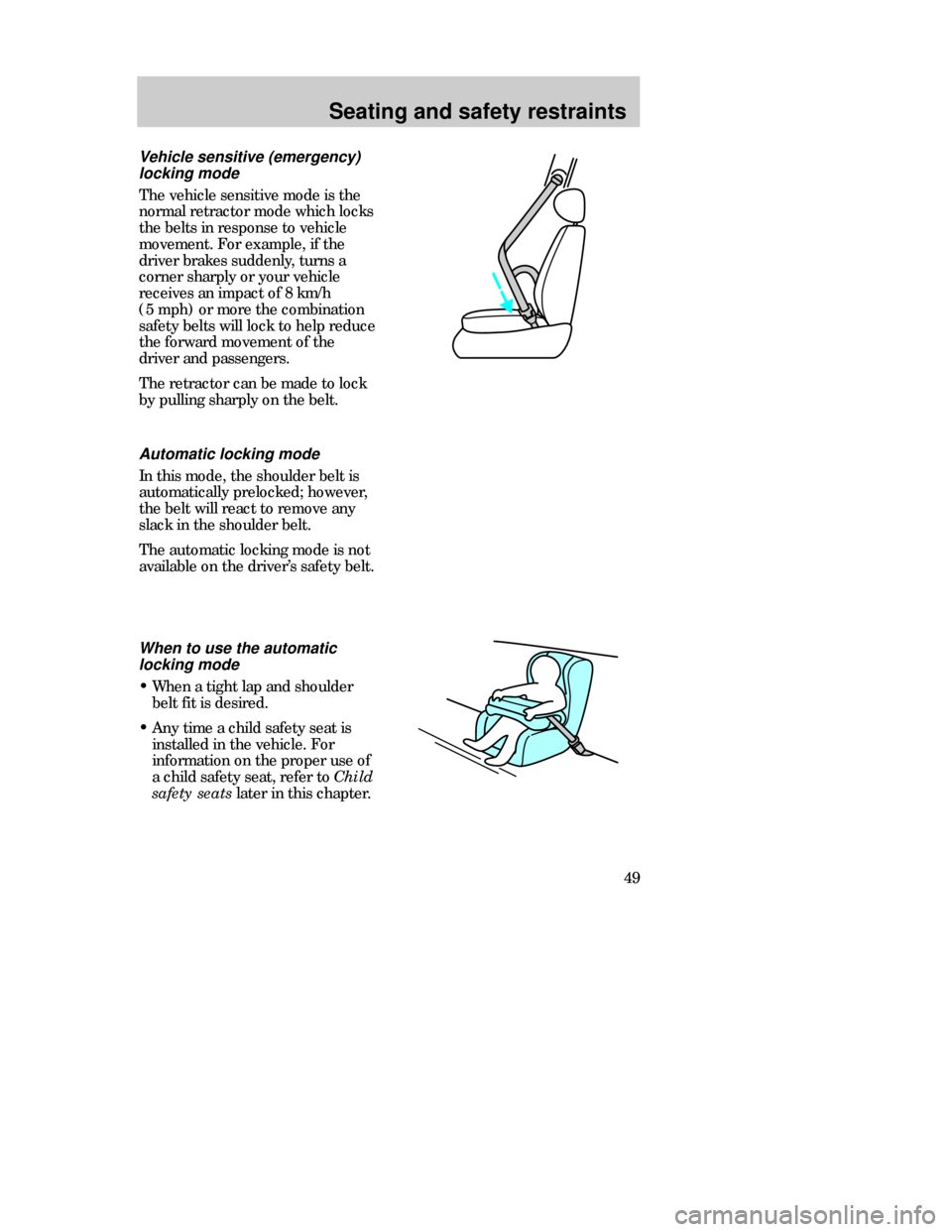Mercury Mystique 1998 s Service Manual
Manufacturer: MERCURY, Model Year: 1998, Model line: Mystique, Model: Mercury Mystique 1998Pages: 196, PDF Size: 1.65 MB
Page 41 of 196

Controls and features
41 PASSIVE ANTI-THEFT SYSTEM
(if equipped)
The Passive Anti-Theft system
(PATS) is an engine immobilization
system. It is an additional theft
protection feature which prevents
the engine from being started
unless a coded key is used..
This system is only available with
2.5 l engines.
POWERAUDIOAM/FM
SCAN
SEEK 312645ANSSIDE1-2EJECTVOLUME
DEF
LO
HIOFFPNL/FLR
PANEL
A/CFLOOR
FLR
DEF
MAX
A/C
EF 1
/
2UNLEADED FUEL ONLY
BRAKE
:
I0 20
Res
Set
AccCoast
Automatic arming
The system is armed five seconds
after switching off the ignition.
The armed status is indicated when
the control light flashes every
twoseconds.
Automatic disarming
Switching on the ignition disarms
the system if the correct code is
recognized.
Keys
Your vehicle is supplied with two
coded keys.
Only these keys can be used to
start your vehicle.
CDW IIIC3Cont en MM 5/15/97 7:45 PM Page 41
Page 42 of 196

Controls and features
42
:
I0 20
Functional check
When the ignition is switched on,
the control light in the digital clock
will illuminate for approximately
threeseconds to indicate that the
system is operating correctly.
If the control light flashes rapidly
for approximately one minute and
then repeatedly at irregular
intervals, the system did not
recognize the key code. Remove
the key and try again.
If the control light illuminates
continuously for approximately
oneminute and then flashes
repeatedly at irregular intervals, a
system malfunction has occurred.
Have the malfunction repaired by
your dealer or a qualified
technician as soon as possible.
To ensure a trouble-free exchange
between vehicle and key, do not
shield the keys with any metal
objects.
CDW IIIC3Cont en MM 5/15/97 7:45 PM Page 42
Page 43 of 196

Controls and features
43 Key coding
Replacement keys or a maximum of
15duplicate keys can be coded.
To program a key, cycle ignition
switch from (3) to (1) with a
programmed key. Within five
seconds of this cycle, insert a new
PATS key into ignition and turn to
(3) or (4). If successful, the theft
warning indicator will glow for two
seconds, and the vehicle can be
started. Repeat until all chosen
keys have been programmed.
The control light illuminates to
indicate a successful programming
operation.
Repeat the procedure to program
additional keys.
Your dealer can also delete keys
already programmed.
The system is maintenance free.
If keys become lost, you must have
your dealer clear and reprogram
the code for security reasons.
3
4
21
CDW IIIC3Cont en MM 5/15/97 7:45 PM Page 43
Page 44 of 196

Seating and safety restraints
44
Adjusting the head restraints
Push or pull the head restraint to
the desired height.
Swivel the head restraint forward
or backward to the desired angle.
SEATING
Manually adjusting the seats
Pull the lever located inside the
front edge of the seat to move the
seat forward or backward.
Pull the lever on the outside of the
seat to recline the seat. HEAD RESTRAINTS
Never adjust the driver’s
seat or seatback when the
vehicle is moving.
CDW IIID Seat en MM 5/15/97 7:48 PM Page 44
Page 45 of 196

Seating and safety restraints
45 Adjusting the power seats
(if equipped)
Move the relevant control in the
respective direction to adjust the
seat, seatback and lumbar as
follows:
1
2
3
46
5Seat
(1) Forward and backward
(2) Height of the entire seat
(3) Height of the front of the seat
(4) Height of the rear of the seat
Seatback
(5) Seatback inclination
Lumbar support
(6) Lumbar support
CDW IIID Seat en MM 5/15/97 7:48 PM Page 45
Page 46 of 196

Seating and safety restraints
46
Folding rear seats (if equipped)
Pull the release knob located in the
luggage compartment. Fold down
the seat. The seatback cannot be
released while the built-in childseat
(if equipped) is open.
If you are carrying objects that
might damage the center rear
three-point safety belt, you can
unbuckle the end of the belt from
the small buckle on the seat
cushion and let the retractor reel it
up. Reconnect the belt tongue to
the buckle when you fold the seat
back up.
To raise the rear seatback, push the
seatback upward until it locks in
place. Make sure it is firmly latched
by pushing forward and back on it.
Check to see that the seat
and seatback are latched
securely in position. Keep luggage
area free of objects that would
prevent proper engagement.
CDW IIID Seat en MM 5/15/97 7:48 PM Page 46
Page 47 of 196

Seating and safety restraints
47
Important safety restraints
precautions
The use of safety belts helps to
restrain both driver and passenger
in case of a collision. In most states
and Canada, the law requires the
use of safety belts.
Always drive and ride with
your seatback upright and
the lap belt snug and low across
the hips.
Lock the doors of your
vehicle before driving to
lessen the risk of the door coming
open in a collision.
Cargo should always be
secured to prevent it from
shifting and causing damage to the
vehicle or harm to passengers.
To prevent the risk of injury,
make sure children sit where
they can be properly restrained.
SAFETYRESTRAINTS
Front and rear seat
occupants including
pregnant women, should wear
safety belts for optimum
protection in an accident.
CDW IIID Seat en MM 5/15/97 7:48 PM Page 47
Page 48 of 196

Seating and safety restraints
48
Combination lap and shoulder
belt
Insert the tongue into the slot in
the buckle to fasten.
Push the red release button and
remove the tongue from the slot to
unfasten.
The passenger safety restraints in
the vehicle are combination lap and
shoulder belts. The front and rear
seat passenger safety belts have
two types of locking modes. Using safety restraints properly
Each seating position in your
vehicle has a specific safety
belt assembly which is made up of
one buckle and one tongue that
are designed to be used as a pair.
Use the shoulder belt on the
outside shoulder only. Never wear
the shoulder belt under the arm.
Never swing it around your neck
over the inside shoulder.
Never use a single belt for more
than one person.
CDW IIID Seat en MM 5/15/97 7:48 PM Page 48
Page 49 of 196

Seating and safety restraints
49
Automatic locking mode
In this mode, the shoulder belt is
automatically prelocked; however,
the belt will react to remove any
slack in the shoulder belt.
The automatic locking mode is not
available on the driver’s safety belt.
When to use the automatic
locking mode
•When a tight lap and shoulder
belt fit is desired.
•Any time a child safety seat is
installed in the vehicle. For
information on the proper use of
a child safety seat, refer to
Child
safety seatslater in this chapter.
Vehicle sensitive (emergency)
locking mode
The vehicle sensitive mode is the
normal retractor mode which locks
the belts in response to vehicle
movement. For example, if the
driver brakes suddenly, turns a
corner sharply or your vehicle
receives an impact of 8 km/h
(5mph) or more the combination
safety belts will lock to help reduce
the forward movement of the
driver and passengers.
The retractor can be made to lock
by pulling sharply on the belt.
CDW IIID Seat en MM 5/15/97 7:48 PM Page 49
Page 50 of 196

Seating and safety restraints
50
Canceling automatic locking
mode
Disconnect the combination lap
and shoulder belt and allow it to
completely retract. This will cancel
the automatic locking mode and
activate the vehicle sensitive
(emergency) locking mode.
Using automatic locking mode
The automatic locking mode must
be used when installing a child
safety seat in any passenger seat.
1. Buckle the combination lap and
shoulder belt.
2. Grasp the shoulder belt portion
and pull downward until the entire
belt is extracted.
3. Allow the belt to retract. As the
belt retracts, you will hear a
clicking sound. This indicates that
the safety belt is now in the
automatic locking mode.
CDW IIID Seat en MM 5/15/97 7:48 PM Page 50